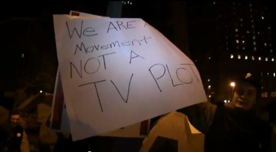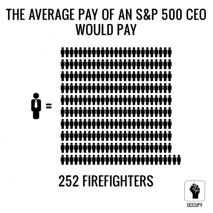The Revolution Out There
Last fall when occupations emerged across the country, I found myself occupying two worlds of political possibility. One—consisting mostly of academic friends—was full of energy to create a more just society. Another—made up largely of colleagues at my ad agency job—was apathetic and even annoyed by the disruption caused by the occupiers. How can one account for the difference between these two groups of people? What social factors are at play in the transformation of “radical” students into compliant employees of today’s economy? To answer these questions, it is necessary to explore the unique conditions of so-called “knowledge workers.” This phrase refers to the growing number of people whose primary output is information/knowledge, not tangible goods.[1]
Historically, the cubicle has hardly been a site for radical political struggle.
Demands for revolutionary social change have grown either in places slightly removed from the demands of the economy (e.g. universities, art collectives) or places where people are violently exploited by their work (e.g. factories). Within these struggles, knowledge workers are generally viewed as at best irrelevant and at worst a hindrance for transformative action.[2] However, as the American economy continues to shift towards this non-unionized, highly cerebral form of labor, we need to start taking the political potential (or lack thereof) of the knowledge worker seriously.
Knowledge Work Dissected
The basic rhythm of knowledge work is a rushing staccato. The worker’s attention is set on high-alert and made to process a variety of mentally stressful tasks throughout a given day. The scope of this problem is underlined by the emergence of entire economic theories of attention and self-help books with ominous titles, such as Death by Meeting and Boring Meetings Suck.[3] As Italian thinker Franco “Bifo” Berardi laments, “everywhere, attention is under siege.”[4]
(Nadine Fraczkowski via World of Photographers)
This scarcity of attention has serious consequences for how workers communicate and process information. A 2011 study from the Institute of Psychiatry at the University of London finds that the multi-tasking required by a typical knowledge worker job decreases worker IQ by an average of 10 points. Torn between different projects, mountains of email, and endless meetings, the knowledge worker comes to demand efficiency over provocation. This transformation is brilliantly encapsulated by Ian Parker’s writing on PowerPoint:
PowerPoint…is software you impose on other people…there are great tracts of corporate America where to appear at a meeting without PowerPoint would be unwelcome and vaguely pretentious, like wearing no shoes. In darkened rooms at industrial plants and ad agencies, at sales pitches and conferences, this is how people are communicating: no paragraphs, no pronouns—the world condensed into a few upbeat slides, with seven or so words on a line, seven or so lines on a slide.[5]
Flying through work in a state of distraction, communicating with coworkers is like trying to talk to someone at a noisy bar. Brief, direct exchanges of information take the place of more thought-provoking and considered dialogue. One is barely able to keep all of the information flowing, much less step back to consider the broader context in which this information exists.
The Comfort Economy
Sweeter notes punctuate the maddening tempo of knowledge work; fancy nights out, a wider variety of entertainment options, spas, yoga and drugs. Just as knowledge workers must be ready-at-hand for any updates on their projects, diversions to ease their stress must be available On Demand. Savvy corporations are well aware of this need. In developing the Google Zurich office, the design firm, Camenzind Evolution, “applied ‘emotional comfort’, an approach to design that takes personalities and sensibilities into account. The research based design process was enhanced by a psychologist who analyzed the functional and emotional needs of the Zooglers (i.e. Googlers in Zurich).”[6]
 (Stefan Camenzind of Camenzind Evolution via Office Snapshots)
(Stefan Camenzind of Camenzind Evolution via Office Snapshots)
 (Stefan Camenzind of Camenzind Evolution via Office Snapshots)
(Stefan Camenzind of Camenzind Evolution via Office Snapshots)
Confronted with diffuse sources of stress and anxiety, knowledge workers are taught to unplug through a plethora of comforts and conveniences. As former President George W. Bush put it in a 2006 speech on spurring economic growth, “go shopping more.”
Our obsession with comfort contributes to apathy and disdain towards those pursuing radical social change. Consider a common complaint about the occupations: ‘Isn’t there a quieter, less disruptive way for protestors to voice their concerns? One that doesn’t disrupt my life?’
Consumable Politics
The interplay of stress and comfort creates a closed circuit that keeps many knowledge workers operating in a space removed from broader socioeconomic struggle. The mental intensity of knowledge work reduces the capacity and desire for complex inter-personal communication, while also training workers to prefer simple, easy to consume bits of information. At the same time, a culture of comfort and consumption submit activism to the rule of maximum convenience. These two phenomena create a negative feedback loop that maintains a cycle of anxious consumption while lowering the capacity for questioning the economic and political structures that dominate society.
In this environment, politics is reduced to an act of consumption. Every couple of years, people are presented with a choice between two relatively similar candidates and asked to pick a side. Each party spends an excessive amount—an estimated $6 billion in the 2012 Presidential Election—to differentiate their candidate and ensure voters make the right decision.[9] At the end of yearlong campaigns, people mark a ballot one way or another and go back to their normal lives.
In a society suffering from attention fatigue, even radical modes of political resistance are undermined. Strikes, union disputes and protests become objects of consumption. Struggle is consumed as a spectacle and then spit out for lacking coherence.[10] Recall a popular critique of Occupy Wall Street: ‘What’s their goal?’ This line of criticism assumes politics comes as a ready-made brand to consume, wear, etc. Like an impatient boss who’s running late to a meeting, we demand protestors get to the point, with little empathy or willingness to get involved in the process.
However, the power of movements like Occupy lies in not in the message but the action. As Bifo summarizes, “the main stake of street actions is the reactivation of the body…bodily sensibility, blurred and stressed by precarity and competition, are finding new modes of expression, so that desire may begin flowing again.”[11] The revolution “out there” is made a media spectacle in order to keep the knowledge worker “in here,” where it’s nice and cozy with plenty of work to be done. What possibility exists for disrupting complacency and alienation amongst knowledge workers?
Class Consciousness is Not Enough
In other types of work class consciousness plays a key role in fighting oppressive structures. As with the recent Walmart strikes, workers bound together by shared experiences of exploitation unite as a class and begin acting in a collective manner, whether that means placing explicit demands on management or simply refusing to work.[12]
This concept of class consciousness is utterly inadequate for addressing the situation of knowledge workers. Most knowledge economy jobs lack the infrastructure of collective communication and shared experience necessary for true class consciousness. Management structures are flat and decentralized. Teams often consist of less than ten people. This structure localizes frustrations and potential communication. Conflicts die in the capillaries of the organization without the larger organization or management being made aware.
More fundamentally, the focus on the individual worker stands in opposition to traditional models of class organization. Workers are hired not just based on a checklist of skills but a series of intangibles. This somewhat personality-based approach individualizes workplace struggle. What could be considered generalized problems with a forum of work—being over-worked, too many meetings, nasty clients, etc.—become personal challenges to overcome. Struggle is internalized.
Reactivating Political Potential
Resisting the cerebral modes of control facing knowledge workers starts by reclaiming mental space. As Micah White proclaims, “The future of activism is an insurrection of the mental environment–a movement that appropriates tactics reserved for physical battles and applies them to the battle to protect our mental environment.”[13] While there is no program for this process, White’s proposal suggests a couple of areas for exploration.
For starters, we should think about placing mental blockades on both the attention-sapping technologies of knowledge work and the consumption of comfort. This could take the form of leaving work e-mail and computers at the job site instead of bringing them home. It might also mean instituting zero-spending days, as many May Day protestors practiced this past year. Creating separation from the negative feedback loop of attention fatigue and convenience is necessary to open mental space for new thinking to emerge.
Second, we should think about creating better strategic maps for the problems facing knowledge workers. Rather than looking at attention fatigue as a personal problem, we should consider these problems as shared structural aspects of knowledge work. Collective mapping of mental workspaces may help reveal generalized conditions that knowledge workers can organize around.
Finally, we should consider redeployment of our knowledge skills for justice-focused purposes. One extremely inspiring example of this is Occupy Design, a decentralized group of designers who organized in the fall of 2011 to provide an ever-growing, striking visual language for the 99%.
Skill-based collectives like Occupy Design offer knowledge workers a way to utilize their knowledge in new context. They demonstrate the power of applying skills that may have been learned in work contexts to radical social struggle.
Although there is no one-size-fits-all solution to the problems faced by knowledge workers and further experimentation is undoubtedly necessary, each of these interventions holds the potential to begin breaking through complacency and activating knowledge workers towards building a better society.
[1] ^ The phrase “knowledge worker” was coined by management consultant Peter Drucker in his 1959 book Landmarks of Tomorrow. Examples include: computer programmers, copywriters, consultants, private equity analysts, etc. This type of labor is qualitatively different from industrial labor, which values (repetitive) physical labor.
[2] ^ “They’re the knowledge workers, not us. We just follow orders, nothing more, nothing less.”
Source: “Organizing an Inside Strike,” Socialist Worker, September 6, 2011, http://socialistworker.org/2011/09/06/organizing-the-inside-strike
[3] ^ In the early seventies, Nobel prize winning economist Herbert Simon summarized the scarcity of attention as follows, “… a wealth of information means a dearth of something else – a scarcity of whatever it is that information consumes. What information consumes is rather obvious: it comes the attention of its recipients. Hence a wealth of information creates a poverty of attention, and a need to allocate that attention efficiently among the overabundance of information sources that might consume it.” Today, myriad books and articles have been written on the “attention economy” and how to reclaim productivity from the jaws of busy-ness.
[4] ^ Franco “Bifo” Berardi, trans. Francesca Cadel and Giuseppina Mecchia, The Soul at Work, p. 108
[5] ^ Ian Parker, “Absolute Powerpoint,” The New Yorker, May, 28, 2001,
http://www.newyorker.com/archive/2001/05/28/010528fa_fact_parker
[6] ^ Sun Joo Kim, “Google Zurich reworks office design,” Smart Planet, October 16, 2011, http://www.smartplanet.com/blog/design-architecture/google-zurich-reworks-office-design/1202
[7] ^ Read more on the origin of the term retail therapy and learn about academic studies “proving” the effectiveness of this therapy here:
http://www.huffingtonpost.com/2011/06/22/retail-therapy-mood_n_882062.html
[8] ^ Center for Responsive Politics OpenSecrets blog, October 31, 2012
http://www.opensecrets.org/news/2012/10/2012-election-spending-will-reach-6.html
[9] ^ “Worker dies at Long Island Wal-Mart after being trampled in Black Friday stampede,” NY Daily News, November 28, 2008, http://www.nydailynews.com/new-york/worker-dies-long-island-wal-mart-trampled-black-friday-stampede-article-1.334059#ixzz2FYs3q9VQ
[10] ^ The transformation of a political movement into a terrifying spectacle can be seen in Bill O’Reilly’s labeling of the movement as “terrorists.”
http://www.youtube.com/watch?v=PDbBS1I8Y94
[11] ^ Franco “Bifo” Berardi, The Uprising: on poetry and finance, p.143
[12] ^ Read more on the recent strikes from Jane Slaughter, “What We Learn from Two Strikes at Walmart Warehouses,” September 30, 2012, http://www.alternet.org/labor/what-we-learn-two-strikes-walmart-warehouses
[13] ^ Micah White, “The Future of Activism,” Adbusters, December 2, 2009





